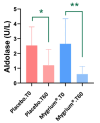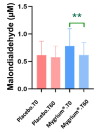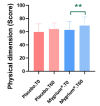Nutraceutical Supplementation as a Potential Non-Drug Treatment for Fibromyalgia: Effects on Lipid Profile, Oxidative Status, and Quality of Life
- PMID: 39337423
- PMCID: PMC11432491
- DOI: 10.3390/ijms25189935
Nutraceutical Supplementation as a Potential Non-Drug Treatment for Fibromyalgia: Effects on Lipid Profile, Oxidative Status, and Quality of Life
Abstract
Fibromyalgia (FM) is a chronic syndrome of unknown etiology, although many studies point to inflammation, oxidative stress, and altered mitochondrial metabolism as some of the cornerstones of this disease. Despite its socioeconomic importance and due to the difficulties in diagnosis, there are no effective treatments. However, the use of non-drug treatments is increasingly becoming a recommended strategy. In this context, the effects of supplementation of FM patients with an olive (poly)phenol, vitamin C, and vitamin B preparation were investigated in this work, analyzing complete blood count, biochemical, lipid, and coagulation profiles, and inflammation and oxidation status in blood samples. To gain a better understanding of the molecular mechanisms and pathways involved in the etiology of FM, a proteomic study was also performed to investigate the mechanisms of action of the supplement. Our results show that the nutraceutical lowers the lipid profile, namely cholesterol, and improves the oxidative status of patients as well as their quality of life, suggesting that this product could be beneficial in the co-treatment of FM. ClinicalTrials.gov (ID: NCT06348537).
Keywords: fibromyalgia; inflammation; lipid profile; olive oil; oxidative stress; polyphenols; proteomics.
Conflict of interest statement
The authors declare no conflicts of interest. The authors declare that this study received funding from Solvitae Medical S.L. The funder was not involved in the study design, collection, analysis, interpretation of data, the writing of this article or the decision to submit it for publication.
Figures






References
-
- Rahman M.S., Winsvold B.S., Chavez Chavez S.O., Borte S., Tsepilov Y.A., Sharapov S.Z., Pain H.A.-I., Aulchenko Y.S., Hagen K., Fors E.A., et al. Genome-wide association study identifies RNF123 locus as associated with chronic widespread musculoskeletal pain. Ann. Rheum. Dis. 2021;80:1227–1235. doi: 10.1136/annrheumdis-2020-219624. - DOI - PMC - PubMed
Publication types
MeSH terms
Substances
Associated data
Grants and funding
LinkOut - more resources
Full Text Sources
Medical

